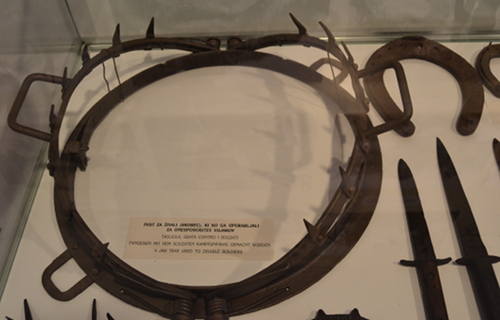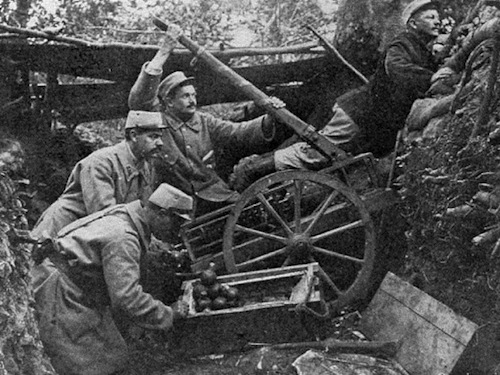Medieval Arms and Armor in World War One

After the initial couple of months of World War One, the front stagnated and both sides began to dig in. The war settled in for four years of trench warfare. While trench warfare was nothing new — the American Civil War, Russo-Japanese War, and the Balkan Wars all saw the use of trenches — this was on an unprecedented scale.
The new situation called for new measures. None of the participating armies had an adequate number of grenades and it took a year for supply to catch up with demand. Some countries never managed to produce enough. Artillery commanders discovered that shrapnel, deadly in the open battles of the past, did little against entrenched enemies unless the gunners were lucky enough to score a direct hit. There was a long lag before enough high explosive shells made it to the front.

Soldiers also found that while the trench provided decent protection, it wasn’t enough. No army in 1914 issued their men with steel helmets. It took more than a year, and countless thousands of men being killed by head shots, before governments started issuing steel helmets to the front line troops. In the meantime, some soldiers bought or made their own helmets. A few even experimented with creating full suits of armor like the one seen above. While the helmets became universal, the armor never caught on. Struggling through the mud was hard enough without adding to your weight! Those who retained armor tended to be in fixed positions such as machine gun crews.

Soldiers also found that if they ended up taking or defending a trench at close quarters, their rifles and bayonets proved unwieldy in the confined space. Knives and store-bought pistols became popular. More medieval-style weapons were also created. Men busied themselves using whatever they had at hand to produce maces and flails. In 1917, the American army issued a special knife with a hilt formed like a knuckle duster. You can see an example of one of these in an earlier post I did about the Royal Army Museum in Brussels, Belgium. On the other hand, officers soon discarded their swords. They were too long for fighting in cramped trenches, and were a useless burden otherwise. In the early months of the war many officers wrote to their governments asking that new officers not be trained in sword fighting, but the rifle instead.

Soldiers also used whatever objects they already had at hand, such as axes normally used for chopping wood, and entrenching tools sharpened to give them a little extra sting. Many men preferred these crude weapons because the bayonet had a nasty habit of getting stuck in the target. In the regimental history of the 43rd and 52nd Oxfordshire and Buckinghamshire Light Infantry, Cuthbert Baines, commander of B Company, tells of one incident at the 1914 First Battle of Ypres.
“I came across a little man in khaki, cursing and swearing and crying all at once and making the most agonizing noises. He was trying to get his bayonet out of a huge Boche [German]. I gathered that the Boche had surrendered and then had picked up a rifle and tried to shoot his captor, who was so frightened that he shoved his bayonet right into the bony part of the Boche and then got still more frightened when he found that he could not get his bayonet out again. He was simply howling with fright and rage and tugging like a maniac. I told him to leave his bayonet where it was and take the German’s rifle and bayonet, and pick another English one when he could find one.”
So while we often look at World War One as the first truly modern war, the grinding savagery of the trenches turned it into something more primitive.


Sean McLachlan is a freelance travel and history writer. He is the author of the historical fantasy novel A Fine Likeness, set in Civil War Missouri, and several other titles. His most recent novel, Trench Raiders, is set on the Western Front. His historical fantasy novella The Quintessence of Absence, was published by Black Gate. Find out more about him on his blog and Amazon author’s page.
Sherlock Holmes’ creator, Sir Arthur Conan Doyle, was a major proponent of front line soldiers using body armor in World War One. Here’s just one of the letters he wrote about it:
http://www.sshf.com/encyclopedia/index.php/Body_Armour_or_Shields
Bashford Dean, the then-curator of arms and armour at the Metropolitan Museum of Art, actually brought a team together to design a helmet and half-armour for American infantry, but the proposed panoply was rejected by the US Army in favour of merely adopting the British Brodie helmet:
http://www.warhistoryonline.com/war-articles/could-body-armor-have-saved-millions-in-wwi-poor-helmets-a-lack-of-torso-protection-for-men-in-the-trenches.html